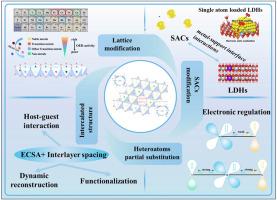Strategies to maximize the oxygen evolution reaction in layered double hydroxides by electronic defect engineering
IF 36.6
Q1 ELECTROCHEMISTRY
引用次数: 0
Abstract
Layered double hydroxides (LDHs) have emerged as highly promising oxygen evolution reaction (OER) catalysts because of their naturally forming two-dimensional (2D) layer structure and intrinsic oxygen vacancies. Numerous efforts to develop synthesis methods as well as modify the structure and composition of LDHs have helped to improve their electrocatalytic performance. Recent strategies to optimize LDHs have gone beyond regulating oxygen vacancies via metal modifications, with innovative ideas of atomic loading and anion-based lattice modification being proposed. In this review, a fundamental understanding of the structural design and its close relationship with the OER mechanism in alkaline media are discussed. Based on the inherent defects and structural characterization of LDHs at an atomic scale, novel progress in promoting OER development activity is summarized, including heteroatomic doping, intercalation, composite construction and single-atom loading. Furthermore, the concept of heteroatoms as electronic defects is emphasized, with the regulation mechanism behind these elucidated by summarizing recent advances in LDHs as highly active OER catalysts. Finally, key challenges to further optimize performance in LDHs catalyst by overcoming the bottleneck of the scaling relationship, expansion of active components and preparation of functionalization, shed light on future research and development directions.

利用电子缺陷工程最大化层状双氧水中析氧反应的策略
层状双氢氧化物(LDHs)由于其自然形成的二维(2D)层结构和固有的氧空位而成为极有前途的析氧反应(OER)催化剂。许多努力发展合成方法,以及修改LDHs的结构和组成,有助于提高其电催化性能。最近优化ldh的策略已经超越了通过金属修饰来调节氧空位,提出了原子加载和阴离子基晶格修饰的创新思想。本文就结构设计及其与碱性介质OER机制的密切关系作一综述。基于LDHs在原子尺度上的固有缺陷和结构表征,总结了促进OER发展活性的新进展,包括杂原子掺杂、插层、复合结构和单原子负载。此外,强调了杂原子作为电子缺陷的概念,并通过总结作为高活性OER催化剂的LDHs的最新进展,阐明了其背后的调控机制。最后,通过克服缩尺关系、活性组分扩展和功能化制备等瓶颈,进一步优化LDHs催化剂性能的关键挑战,展望了未来的研究和发展方向。
本文章由计算机程序翻译,如有差异,请以英文原文为准。
求助全文
约1分钟内获得全文
求助全文

 求助内容:
求助内容: 应助结果提醒方式:
应助结果提醒方式:


